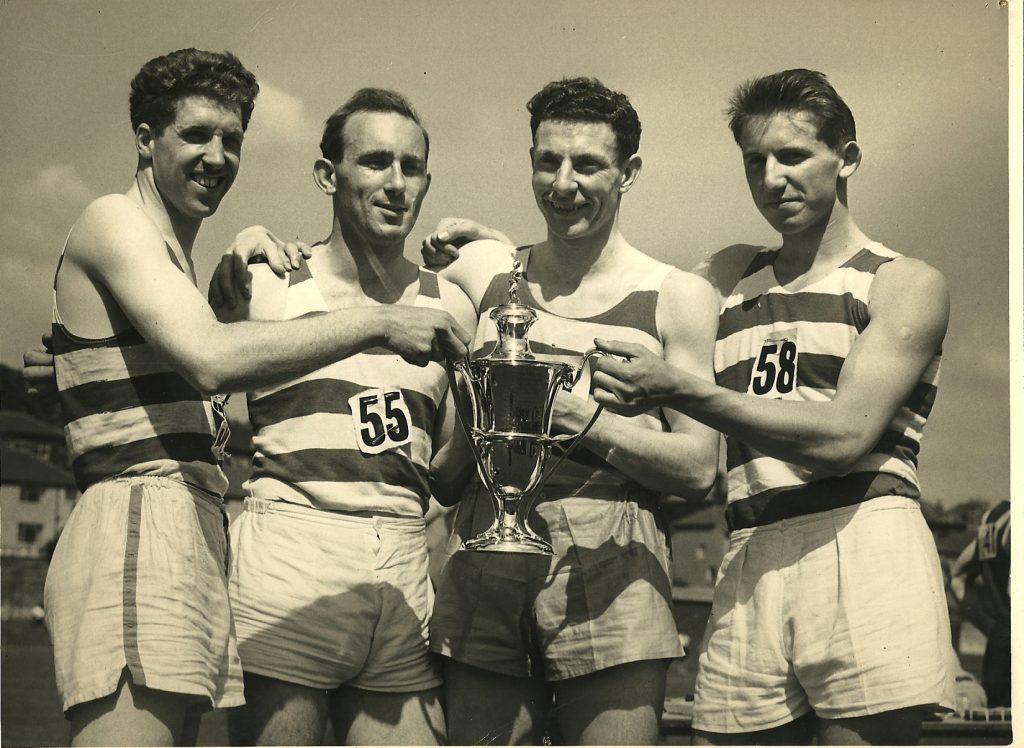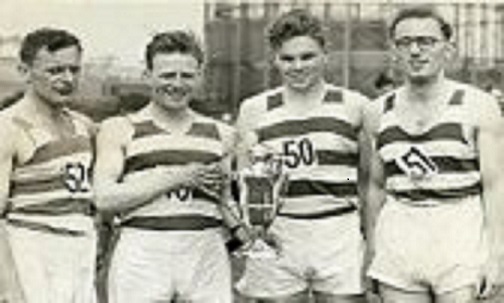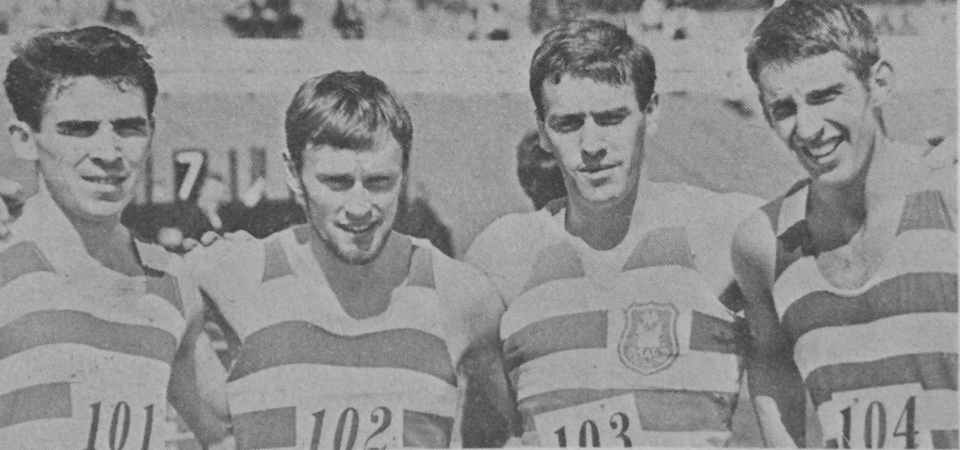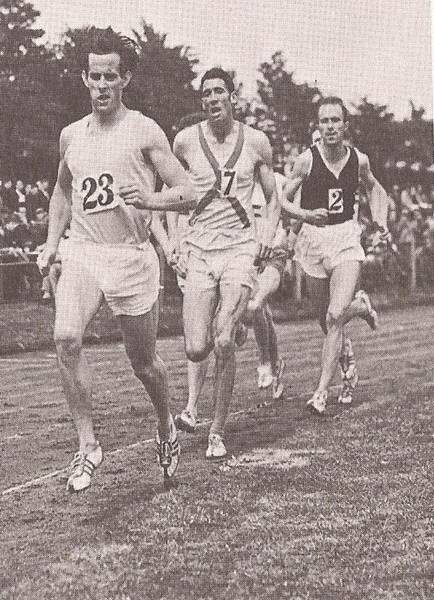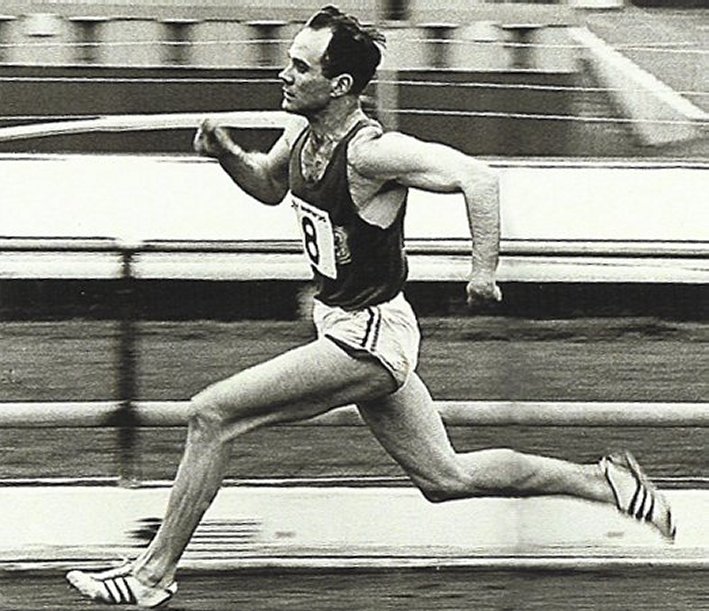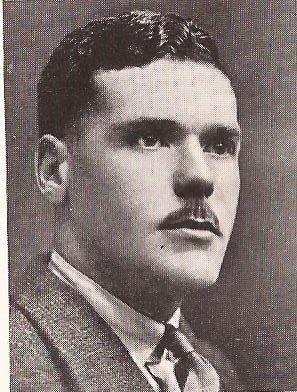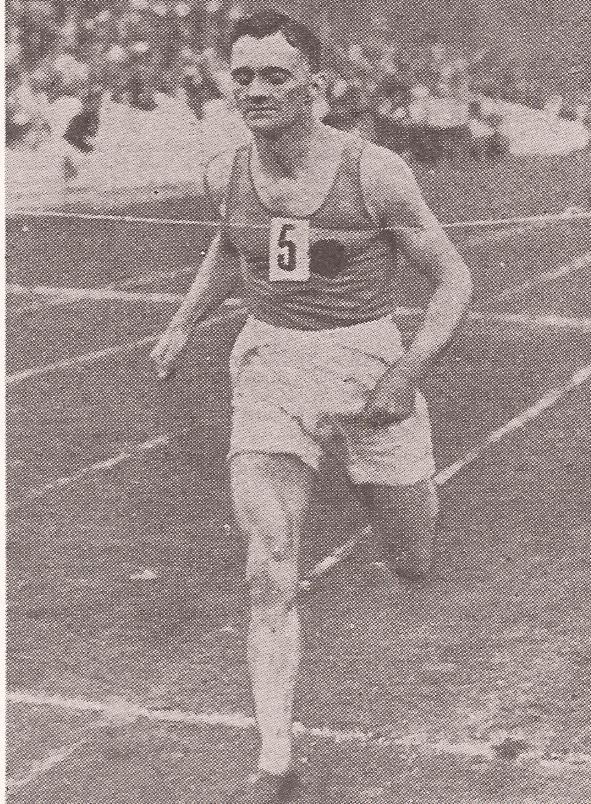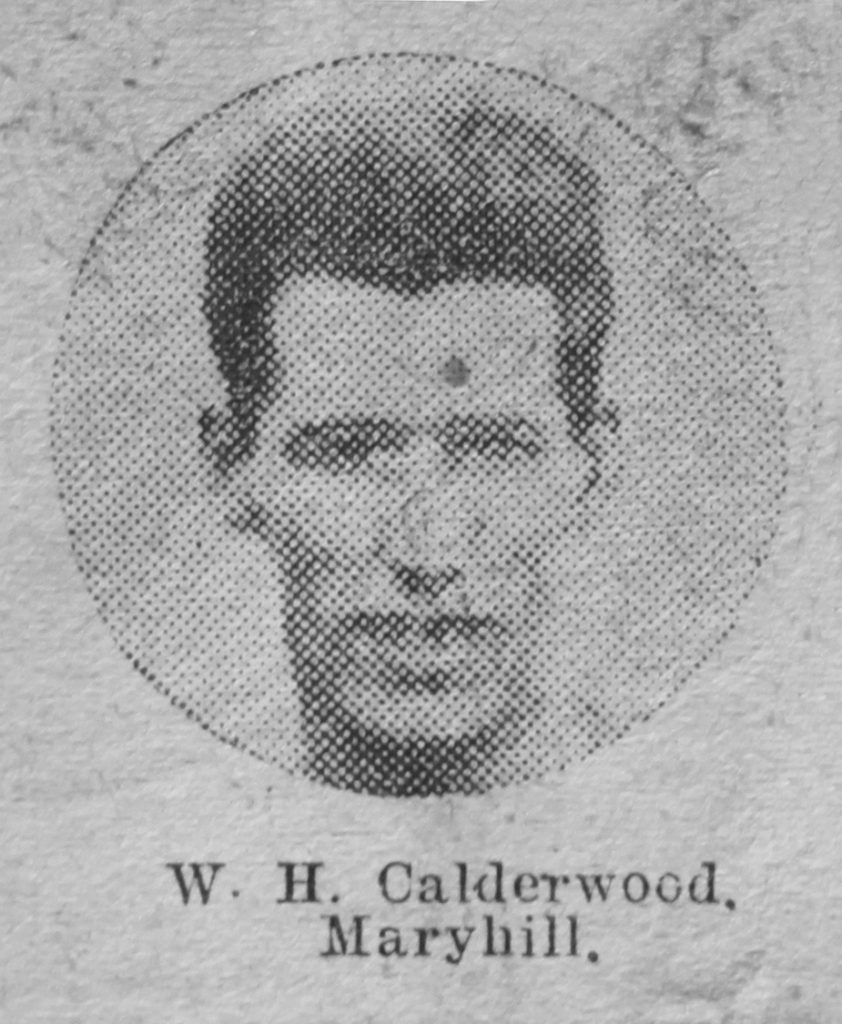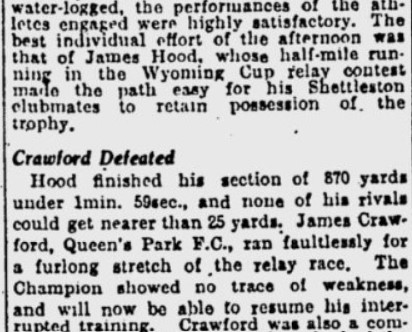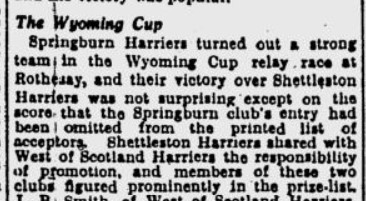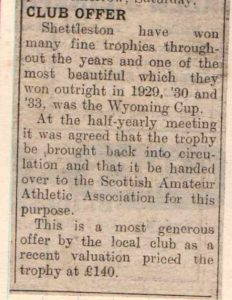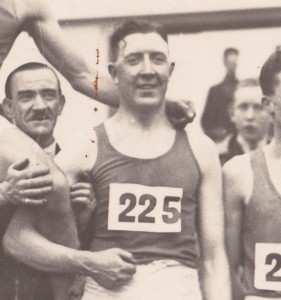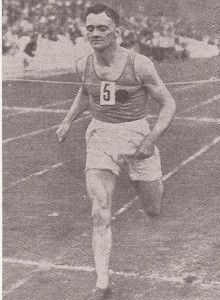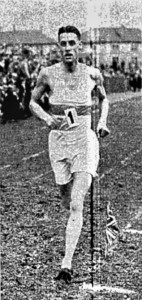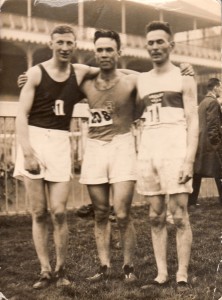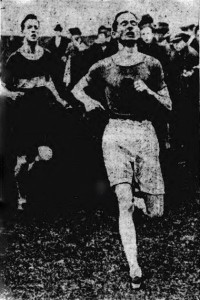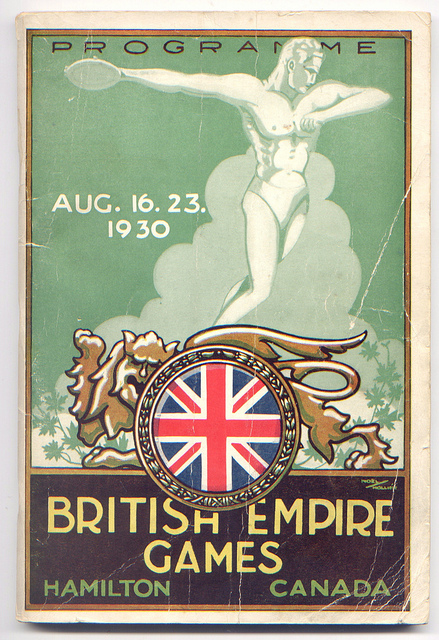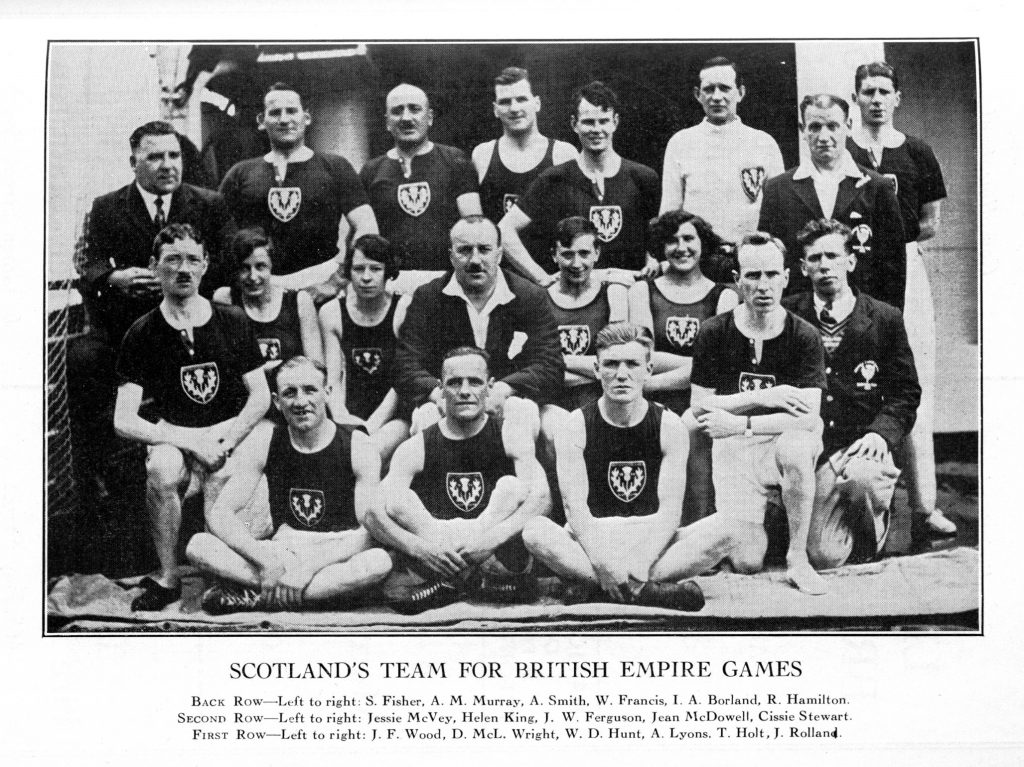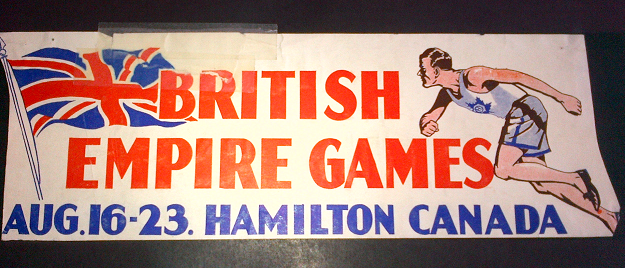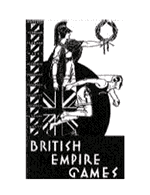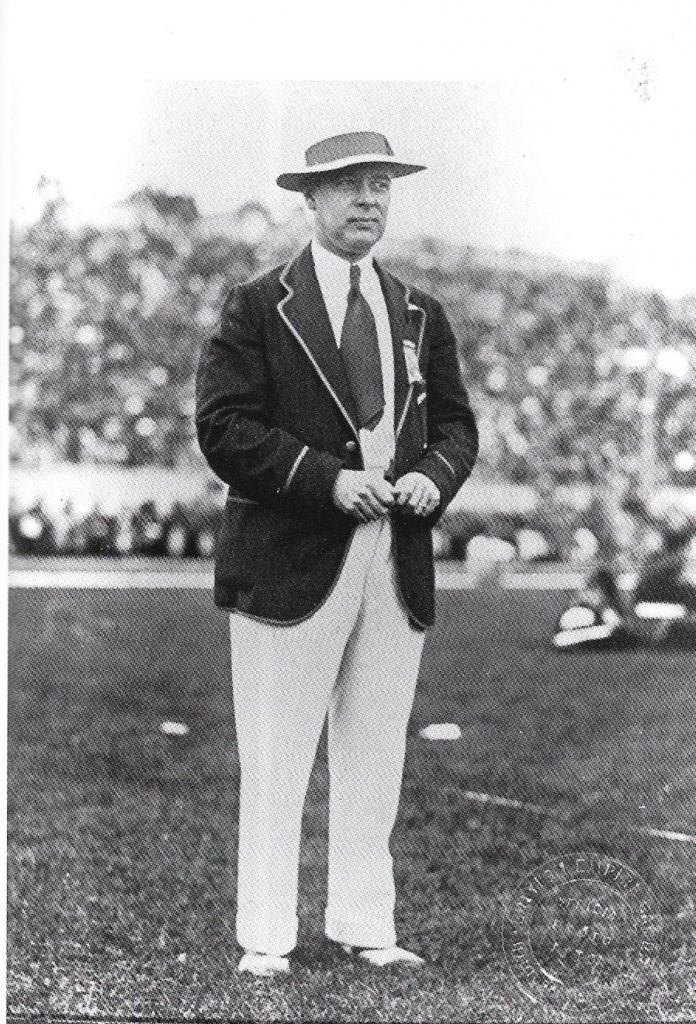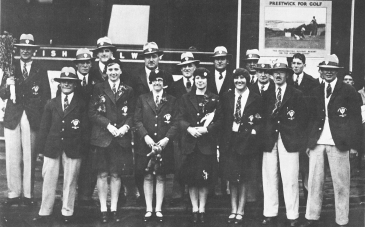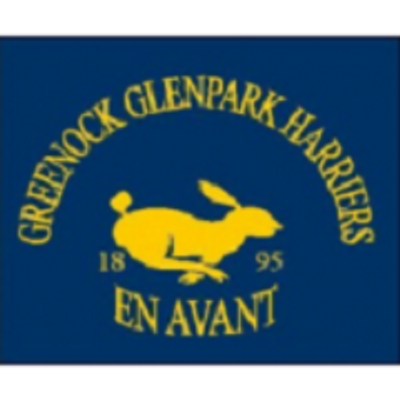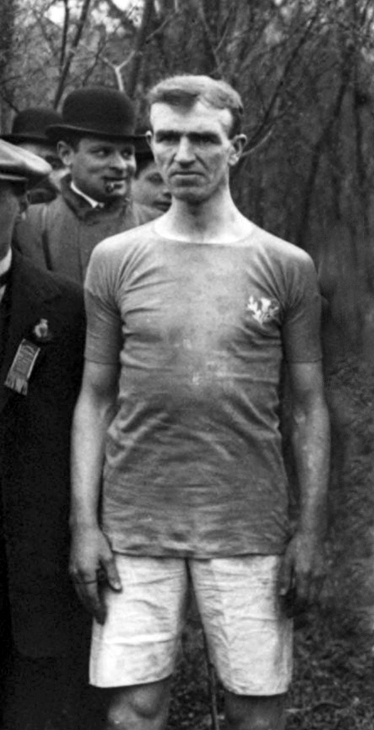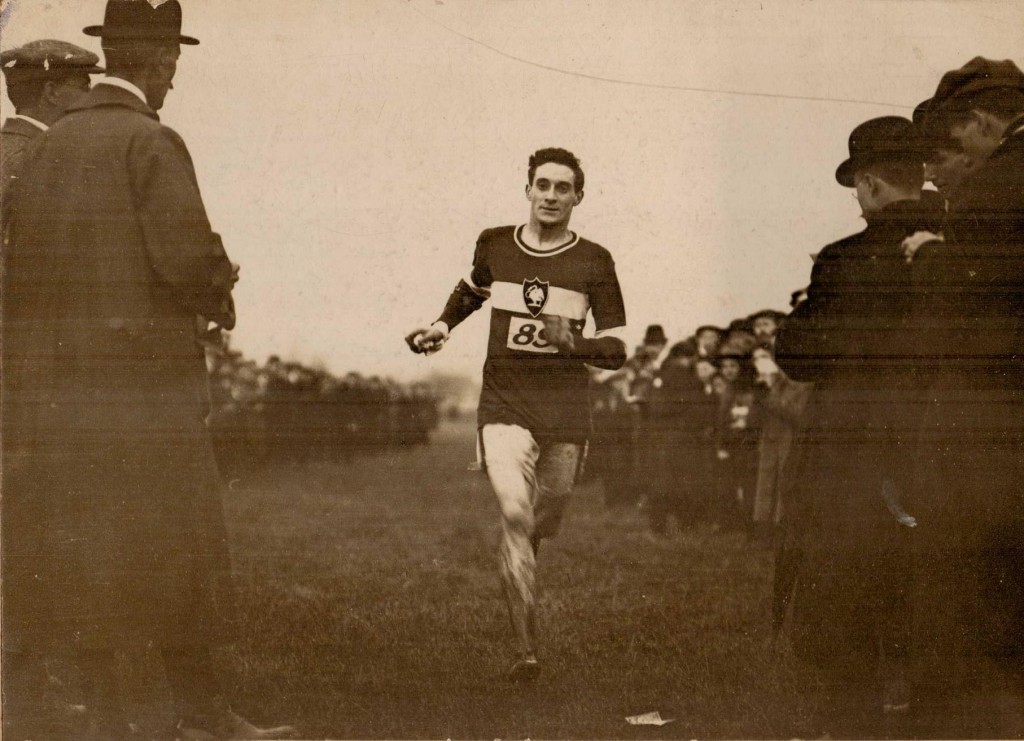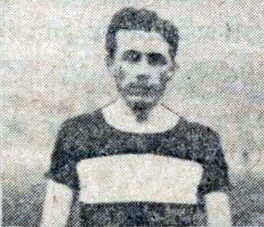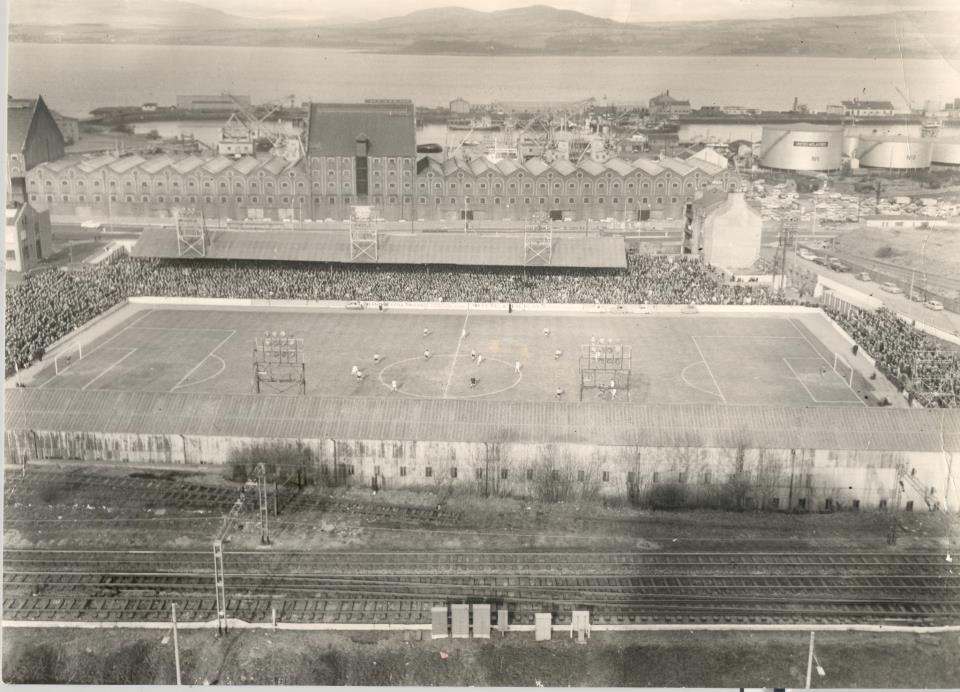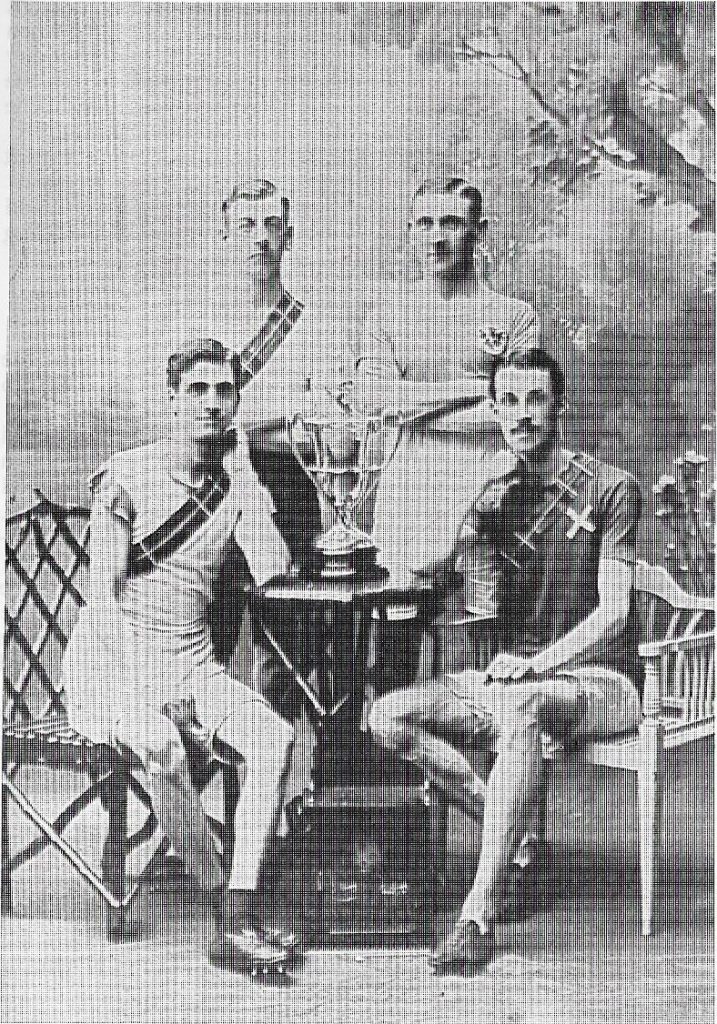
The Teviotdale Harriers team which won the Wyoming Cup in the medley Relay at Hawick Common Riding Games in 1910.
WR Sutherland and AJ Grieve standing, and JS Turnbull and RH Burton
Have a look at those spikes!
Scottish ahletics fans always liked relays. Maybe because of the opportunity to see a baton dropped – the same reason for the clustering of spectators at the water jump at a steeplechase – mabe because of the discipline required not only to get the baton to your team mate without mishap, but to do so within a confined space. That was and is true of both 4 x 100 and 4 x 400. But if they liked relays, they loved the medley relay, sometimes called the mile relay which was a bit confusing because the 4 x 440 was also called a mile relay at times. Teams needed an 800m runner, a 400m runner and two 200m men. The mix of distances, the changes of pace and the final shoot-out over a serious distance rather than a quick dash up the track as in the 100 metres/yards. The Scottish way of doing the event was to start with the half mile, follow that with two furlongs and finish with a quarter mile; the English way was to have the quarter first and the half last. There are arguments in favour of both orders but in recent years Scots seem to have given way to the foreign method – much to the irritation of some of us!
Although there was no SAAA Championship for the medley until 1919, the event was hotly contested since before 1909 when the Wyoming Cup was first competed for at Hawick. What follows explains the title but because it was originally featured at the relatively small Hawick amateur meeting, there were results when the result was not published nationally. However it was written up, the first race was on 12th June 1909 and was previewed in the ‘Glasgow Herald’ as follows: “Hawick FC are giving a £20 cup for a relay race on June 12th, and from this district West of Scotland Harriers and Bellahouston Harriers will send teams. The distances are two 220 yards, 440 yards and 880 yards. John McGough will run the half-mile distance for Bellahouston, and either J Fairbairn-Crawford or J Hepburn will represent the West of Scotland Harriers.”
The race was reported in the ‘Glasgow Herald’ on 14th as follows:
“HAWICK. One Mile Team Relay Race for the Wyoming silver challenge cup (presented by Hawick Callants in Wyoming, USA). 1. West of Scotland Harriers (RC Duncan, John Miller, George Hepburn, D Fairbairn Crawford); 2. Heaton Harriers. Crawford finished grandly for the winners, and there was a rare run in between Jameson of Heaton, and Grieve of Teviotdale for second place. The winning team each received a prize worth 20/-.”
In 1910 Teviotdale Harriers, third the year before, won the trophy with a team of AJ Grieve, WR Sutherland, JS Turnbull and RH Burton. Then before the race in 1911, the ‘Glasgow Herald of May 15th, 1911, said: “The Hawick “Callants” who form quite a colony now in Wyoming, and who two years ago gave a handsome challenge cup for the one mile relay at the Hawick Common Riding Sports, are sending home this year £20 as a further donation. In consequence, the Committee have decided to double the value of the prizes for this race. The winning four will receive awards of the value of £2:02:00 and the runners-up and third team prizes will be worth £1:01:00 and 10/6 respectively. The sports will be held on Friday, June 9th, and Mr James Thomson, ex-President of the Scottish Border AAA is again the secretary.”
Came Friday, 9th June and the cup was won by West of Scotland Harriers from a Teviotdale team which was basically the same as the year before, the only change being JM Ballantyne for Turnbull. The Centenary History of Teviotdale Harriers elaborates on the origins of the Trophy as follows.
“Between the years 1909 and 1913 a star attraction at the Common Riding Games was a one-mile team relay for the Wyoming Silver Challenge Cup presented by the Hawick Callants in Wyoming, USA. Valued at 22 guineas, the solid silver cup, weighing over 70 ounces, was supplied by Mr FE Rutherford, jeweller, Hawick, and was according to the rules “open to all amateur harriers clubs in Great Britain and Ireland/” Intimation of the handsome 18″ high cup in the form of a loving cup with three handles, was sent by ‘Teri’ exile Mr Frank Deans who had taken a great interest in athletics when in Hawick. His initiative in procuring 20 subscribers was evidence of the interest he and other exiled Teries had of their native town. “
The trophy was won almost exclusively by either West of Scotland Harriers from Glasgow and Teviotdale Harriers – after three races it was West two wins and Teviotdale one but the score was evened out on 8th June, 1912 when the Glasgow Herald reported: Amateur Sports at Hawick. Team Relay Race for the silver Wyoming Cup and prizes. – 1. Teviotdale Harriers (T Bell, JM Ballantyne, WR Sutherland, RH Burton); 2. West of Scotland Harriers (JH Rodger, RC Duncan, HJ Christie, WS Unkles). Time: 3 min 48 sec.
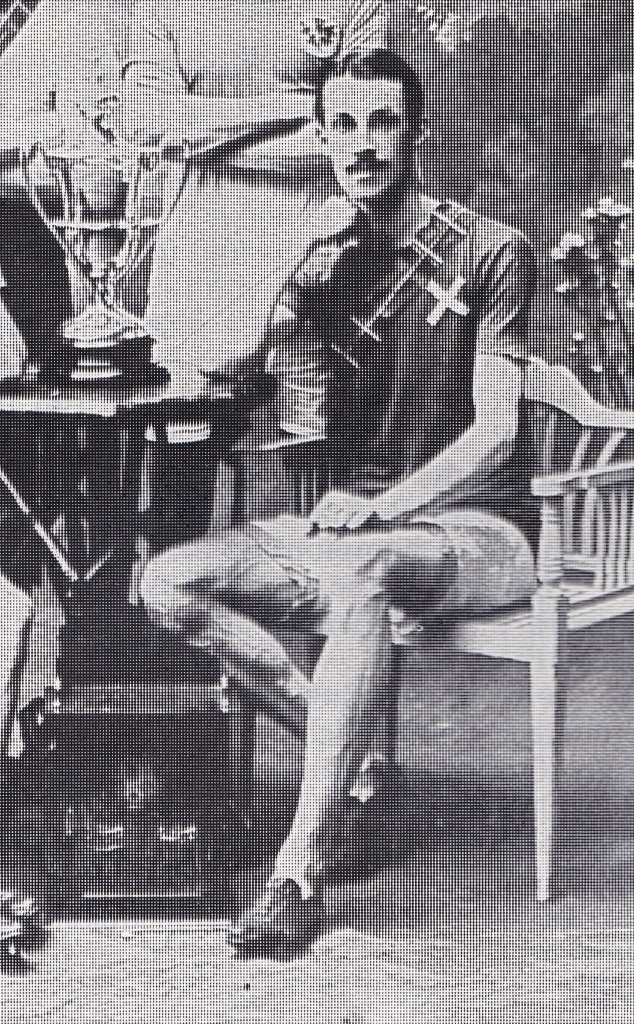
Robert Burton: the trophy can perhaps be seen more clearly in this one.
Records of the West of Scotland Harriers at this time tell that the entry fee was four shillings and sixpence per team, and the importance of the event was shown in their willingness to pay travelling expenses from Glasgow to Hawick for the runners. eg 1914’s fares and expenses amounted to £2:08:4. In 1913 the situation was complicated. It was a time when it was not unusual for a team which won a trophy three times, or more usually three times in succession, was allowed to keep it for their own use or trophy cabinet and there was a variation written into the rules for the Wyoming Cup. The Teviotdale history again: “the situation for 1913 was that each club had two wins to their credit and the rules stated that three wins would give absolute custody. That year it once again went to West of Scotland and so they claimed permanent possession. Teviotdale’s team of Bell, Ballantyne, Sutherland and Burton were runners-up. Investigation since has revealed that the West team (JH Rodger, RC Duncan, HJ Christie and G Dallas), contrary to the rules laid down for the competition did not comprise a full complement of first claim members, the last named being from Maryhill Harriers, and so in actual fact should have lost the cup by default.”
George Dallas was well known in Scottish athletics and was never anything other than a member of Maryhill Harriers and he was an easy man to recognise as well as being a talented athlete at distances from 100 yards to the half mile. However, the following passage had appeared in the ‘Sports Miscellany’ column of the Glasgow Herald of 19th May, 1913:
“Dallas and Hamilton, both of Maryhill Harriers, have joined the “West”, whose racing ranks are in consequence greatly enriched, as the former is the best half-miler in Scotland, while George Hamilton is one of the best short mark sprinters. It is just possible, however, that Dallas and Hamilton will continue to run in their old colours, though by doing so, they deprive themselves of the privileges which are only shared by those who compete regularly in the pale blue and black stripes of the “West” Harriers.”
It looks as though there was a kind of second-claim connection with the West of Scotland Harriers: eg on 8th July, 1913, Dallas ran in the Maryhill Harriers Sports as ‘G Dallas, Maryhill Harriers.’ Jump to August and in the Rangers FC Sports on the first Saturday, Hamilton was listed in the results as ‘G Hamilton, Maryhill and West of Scotland Harriers’, then a week later he was at Celtic FC Sports as ‘G Hamilton, Maryhill Harriers’. At the Celtic meeting, Dallas was a member of the West team which finished third in the Invitation Relay although he did not appear in the results anywhere else. Was the run at Hawick legal by the standards prevailing? That depends on (a) whether the rules stipulated first or second claim runners only, and (b) what Dallas’s status actually was. The West of Scotland handbook for season 1913/14 reported that “‘The club has competed this season in several Relay Races. At Hawick we won the Wyoming Challenge Cup for the third time, and this now becomes our absolute property.” What happened next to the trophy? West took it home to Glasgow and put it up for competition at some of their meetings which were held frequently over the summer season and. like other Glasgow clubs, they held the occasional meeting at Dunoon.
In 1914 the Hawick Common Riding Sports took place on 6th June and there was a one mile relay – but the Wyoming Cup was not mentioned in the results. The race was won by West of Scotland with a team of J Dallas, G Hamilton, HJ Christie and D McPhee. McPhee had been a Clydesdale Harrier who had joined West in May 1914 and J Dallas is probably George Dallas, again running for the West. Later in the 1914 season at the Celtic FC Sports meeting on 10th August, 1914, George Dallas was entered in a 1000 yards handicap as “G Dallas (West of Scotland Harriers) 35 yards ” However the West club’s handbook for that season pointed out their relay successes: “Our Club has again been very successful in Relay Racing. At Hawick, Greenock (Glenpark Harriers) and our own meeting we won easily over the 880, two 220 and 440 yards, and at Edinburgh Northern Harriers Meeting we were again successful in winning their Challenge Trophy over the four laps’
The West of Scotland Sports at Ibrox on 14th June, 1919, had a relay race which was won by Maryhill Harriers (Dallas, Goodwin, Hamilton and Colberry) over Greenock Glenpark Harriers. There was no mention of the Wyoming Cup but the report on the meeting the following year seems to indicate that it was indeed up for competition. On 12th June 1920 in a report on a West of Scotland Harriers meeting at Ibrox Park, the report credited Duncan McPhee with helping West win the invitation relay over Maryhill saying: He had not a little to do with the winning of the relay race for his club, the West of Scotland Harriers, who thus checked the career of Maryhill Harriers. The latter won the race last year and the two clubs now own one share each in the Wyoming Cup, which becomes the property of the club winning it three times, not necessarily in succession.” The West team was Christie, Todd, Kavanagh and McPhee and the Maryhill squad contained Bell, Colberry, Hamilton and Dallas.
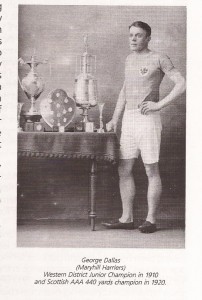
The 1921 race at Ibrox was a joint promotion between West of Scotland and the Glasgow Tramways and was held on 11th June. The report mentioned that the most interesting race on the programme was the mile relay which resolved itself into a duel between West of Scotland and Maryhill Harriers. Dallas and McPhee were the respective half-milers, and the latter ran a great race, finishing a yard ahead and securing the Wyoming Cup for the promoting club.”
10th June 1922 was the date for the next joint West of Scotland Harriers and Glasgow Corporation Tramways AAA meeting at Ibrox and “chief place was given to the relay for the Wyoming Cup, and the West by winning having made the trophy their own for the second time, thanks mainly to the fine running of JCS Ponsford of Glasgow University.” JG McCall, HJ Christie, D McPhee and JCS Ponsford made up the winning team with Shettleston Harriers (Dunbar, Brown, Stevenson and Annand) second. The comment about the West having made the trophy their own indicated to the public that they had won the relay in three consecutive years. This did not stop them putting it up for competition the next year: the race was again held at Ibrox Park and the ‘Glasgow Herald’ in its ‘Notes on Sports’ column of 11th June, 1923, had a special paragraph headed
THE WYOMING CUP
The Harrier clubs in the West who promote open meetings are, of necessity, optimists of the first degree, otherwise the apathy of the public would have cured them of the habit long ere now. Not even the relay race for the Wyoming Cup nor the opportunity of seeing a quarter-mile over hurdles could induce more than a meagre sprinkling of spectators to line the ropes at Ibrox Park, where West of Scotland held their meeting on Saturday. Yet the racing throughout was of the honest description and the times returned in most of the events were quite good. The chief feature did not provide a thrilling race – the superiority of the promoting club when the final quarter was entered was too pronounced for that – but two of the competitors ran very well. These were George Malcolm of the Edinburgh Southern Harriers, who exhibited a fine burst of speed against McPhee in the half-mile and was only beaten by a few yards, and AH Graham of Maryhill Harriers whose effort in the final quarter was worthy of a better fate. AM McKay of Leith ran for Edinburgh Southern but his display over the furlong clearly showed that the Inter-Scholastic champion’s best distance is the quarter. West’s victory, their fourth in succession, was gained by 10 yards from Maryhill Harriers, the other two competing clubs, Edinburgh Southern and Bellahouston Harriers, finishing well down.”
The Inter-Scholastic Championships referred to were the fore runners of the Scottish Schools championships but contested mainly by the fee-paying schools pupils. In the results column, the Cup was again referred to as the chief event in the programme – Scots did and still do like their rrelays and the Mile medley (880, 220,220, 440) had a special place in their affections, and for the clubs concerned it was a magnificnt piece of silverware that FE Rutherford had crafted all those years before.
1924 was Olympic Games year and with selection for the British team important, the SAAA Championships were brought forward to the second Saturday in June – the date of the West of Scotland meeting. With almost every Saturday already being the focus for one established meeting or another (eg Queen’s Park FC, Greenock Glenpark Harriers, Glasgow Police, Partick Thistle all had their regular dates in June or early July) there was no week end sports put on by West of Scotland.
There was no meeting held by West of Scotland in June 1925, either on their own or in tandem with the Tramways or Shettleston, although on June 22nd at the Glasgow Police Sports at Ibrox the mile medley relay was won by Maryhill from West of Scotland Harriers, Calderwood, Duncan, Graham and McCrae making up the team.
On Tuesday June 15th, 1926, the relay for the Wyoming Cup was held once again. This time at the joint Shettleston/West of Scotland Harriers meeting at Ibrox Park. It was won by West of Scotland, represented by McIntyre, Burns, Urquhart and Hope from Shettleston Harriers who had Tom Riddell on the opening half-mile stage, followed by Crawford, Harrison and Stanley. The report commented: “Riddell ran again for Shettleston Harriers in the relay race for the Wyoming Cup and the five yards lead he gained from RB McIntyre gave his side a lead which was maintained until the final quarter. Here JD Hope running very strongly finished an easy winner by 15 yards.”
11th June, 1927 at Celtic Park, the intro read “the chief event of the meeting, the Wyoming Cup for the one mile relay, was won by West of Scotland Harriers after an interesting struggle with Maryhill Harriers.” The team was made up of Mcintyre, Burns, McLean and Hope and the winning time was 3 min 42 3-5th sec.
On the second Saturday of June 1928 most meetings in the West were cancelled because of the weather, only those at Clydebank (Singer’s Sports) and Glasgow University OTC went ahead – although the Hawick Common Riding Sports were ‘ carried through under favourable track conditions as the times returned in various events would suggest.” The one mile relay there was won by Edinburgh University AC from English team, Gateshead Congers. 1928 also saw the birth of a series of annual big inter-club meetings organised by St Peter’s AAC at Scotstoun in Glasgow.
These meetings consisted of a whole series of relays from 4 x 110 yards to four miles relay and including the half mile relay, 4 x 440 yards hurdles relay, mile relay and two miles relay as well as the mile team race, the three miles team race as well as many standard field events. These were held in the middle of June and they may have been a factor in the virtual disappearance of the West of Scotland Harriers meetings.
This is where things get complicated however: although the trail goes cold as far as newspaper reports are concerned, the West of Scotland archive has some information. These contain dates for the “cleaning and engraving of their trophies: in 1920 they specify the Wyoming Cup. In 1928 the relays were mentioned and the engraving was carried out by James McMenamin, engraver. As is the way with different secretaries, details of items such as “engraving and cleaning” are more or less detailed from year to year but after several years of this entry, the note for June 16th 1933 mentions the engraving of the Wyoming Cup at a cost of 7/-. What does all this tell us? It tells us that the cup was in circulation at this time but not what it was awarded for or to whom it was awarded,
*
As an indication of the research that went in to this article, we followed several tracks, not all equally productive but all met with genuine assistance from those approached. First of all, back numbers of the Glasgow Herald were searched; then we contacted Alan Inglis of Teviotdale Harriers who gave us some information and a copy of the club history which had lots of detail on the early years of the club; athletics historian and former West of Scotland member Hamish Telfer gave us lots of information about West of Scotland for their help with this page. He took lots of trouble and searched though old documents for references to the cup (see the note below); Arnold Black, official Scottish athletics historian did some work too. These people are thanked for their help – the quest goes on but, for now, the trail has gone cold. Finally as an indication of the effort taken I quote from just one of Hamish’s emails, his source was the second club cash register:
Wyoming Cup:
Apart from the entries in the members books which I read out in earlier chats, the Cash register has the following:
June 1912: Entry Hawick Relays 4/6
August 1912: Expenses for the team for Hawick 9/6
June 1913: Entry Hawick Relays 4/1
June 1914: Entry Hawick Relays 4/-
Fares and expenses £2/18/4
June 1920: Cleaning and engraving Wyoming Cup £1/0/6
September 26th 1924: Engraving Wyoming Cup 3/6
1928 – Relays mentioned but not Hawick so must have died a natural death. Mention of ‘insuring cups’ but nothing about the WC specifically. James McMennamin the engraver
Nov10th 1930: Engraving and cleaning Wyoming Cup 12/6
Sept 17th 1931: Engraving and cleaning Wyoming Cup 4/-
Jan 16th 1933 Engraving Wyoming Cup 7/-
After this date there was no further mention of the WC until in January 2021 John Mackay of Shettleston Harriers saw from old club handbooks that the club had won the trophy in 1929, 1930 and 1933. Moreover the race involved was at a meeting hosted jointly by West of Scotland Harriers and Shettleston. West had a sports meeting in the third Saturday at Rothesay and part of the attractions at the meeting was the medley relay race. The report on the event of 1930 read
Confirmation there of the club’s victories in both 1929 and 1930. They did not win it in 1931 when they were going for three-in-a-row. The honour this time round went to Springburn Harriers. The Glasgow Herald reported
The result was a win by 5 yards for the Springburn team of Scott, Brownlie, McLaughlin and Davis in 3:44.2 from Shettleston’s team of Hood, McRobert, McKinnon and McGinlay with Maryhill Harriers third. In the beginning it had been a condition of the cup’s donation that it would become the outright possession of the club that won it three times. This was referred to in the very short report on the 1932 meeting, the entirety of which is reproduced below.
MEETING AT ROTHESAY
With the West Kilbride Sports in abeyance, the Shettleston-West of Scotland meeting at Rothesay had the West of Scotland to itself. Better luck in the matter of the weather helped to make the meeting a success financially and from the athletic standpoint. The big event was the mile relay race for the Wyoming Cup, which becomes the property of the first club to win it three times. Springburn Harriers, the holders, succeeded in retaining the trophy which puts them on level terms with Shettleston Harriers with two wins each.
This all added some spice to the meeting of 1933 – equal to that of the very origins of the trophy when Teviotdale and West of Scotland had two wins each. report on the race, held at Dunoon this time reads:
“Running the half-mile for Shettleston in the Wyoming Cup Relay Riddell set up what proved to be a winning lead. This was Shettleston’s third win so that the trophy now becomes their own property. It may be taken for granted however that the cup will again be put up for competition under the same conditions as have prevailed since it was originally competed for at the Hawick Common Riding Games in 1909. Springburn Harriers, winners for the past two years were second. The absence of R Davie and J Scott was too great a handicap yet they have got together a fine young team.”
The question then was, “Would it be put up again by Shettleston under the same conditions?” The Herald report on 23rd July, 1934 read as follows: “The contest for the Wyoming Cup resulted in another victory for the Glasgow Police team, their fourth in relay races within eight days, and the predominance of the national championships at the moment suggests that for the good of the sport, a change should be made and the mile medley displaced by relays over equal distances. Superiority over the half-mile sector of the relay usually results in all interest evaporating before the finish.”
The answer was that the relay be held again and the victorious Glasgow Police team was made up of J Scott, A Miller, M Shaw and R Davie in a time of 3:41.6. They won by 10 yards and it is not a step too far to assume that J Scott and R Davie also won gold relay medals as former Springburn Harriers.
There was another winner in 1935 in the medley relay listed as for the Wyoming Cup – Maryhill Harriers who had last won the trophy in 1919. The winning time was 3:43.6. Only three teams ran with West of Scotland second, ten yards back, and Springburn, who reportedly had their full team out, was third. The comments from the previous year came to mind when the Maryhill lead off man was Bobby Graham, SAAA champion, record holder, Olympian and altogether a class apart from the others who gave his team a winning lead, just as Tom Riddell had done for Shettleston a few years earlier.
In 1936 there was still a medley relay although the Glasgow Herald did not name the Wyoming Cup for the winners. “The promoting club showed early promise in the relay and would probably have won but for faulty baton-passing at the second changeover. Donald McLean gave Maryhill Harriers a two yard lead over AL Spencer, West of Scotland, over the half-mile leg but Norman Glen carried the West to the front again to the quarter mile which was run next. It was the end of this lap however that the leaders fumbled the baton allowing Maryhill to snatch a slight lead which they maintained to the end.”
The winning Maryhill team of McLean, G Terry, TR Hogg and D Reilly won from West and Springburn. The winning time was 3:46.0 and the winning distance was only two yards.
Interestingly the race seems to have been run in the order of 880 yards, 440 yards and then 2 x 220 yards but in 1937 the report said explicitly that it was run that year in the more usual order of 880/220/220/440 yards. Springburn (R Kinloch, CF Campbell, F Waddell and J Carson) from West of Scotland and Glasgow Police in 3:45.0.
It may not have been a follow up of the comments in 1934 that the medley lost its interest if one club had a better half miler than the others, and the suggestion that 4 stages of equal distance would be more attractive, but the meeting on 23rd July 1938 had only one relay and that was over 4 x 220 yards. We are told that at the start of the race A Watson of Garscube ran into another runner, turned a somersault and lost a considerable amount of ground. The result was a win for Maryhill Harriers (WJ Brown, D Bell, J Leckie and R Maclagan) from Glasgow Police and Springburn Harriers in 1:33.6. The Wyoming Cup was not mentioned in the report. It was a half-mile relay the following year and Uddingston Welfare won from West of Scotland and Bellahouston Harriers. The winning team was G Cregan, R Munro, W Fraser and R Dixon and the winning time was 1:33.6.
The War started later that year and sports programmes were distorted. There are however several scenarios for where the Cup went. In the first, it could simply be that Uddingston Welfare kept it. Or the Maryhill team which had won the last running as a medley relay could have kept it, or they could have returned it to the meeting organisers. In any case, the trail of the magnificent old trophy goes cold once again. It can be taken up again if there is any more information comes forward.
And more information did come forward. It came from John Mackay at Shettleston Harriers. Shettleston Harriers club reporter Clark Wallace, writing as Spiker, reported on a committee decision to gift the Trophy to the SAAA.
We now have further information about the Trophy and there remain two puzzles: where was it between 1939 and 1955, and what did the SAAA do with it?
